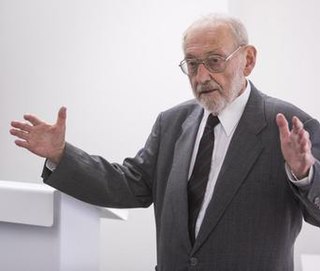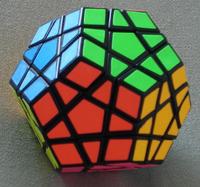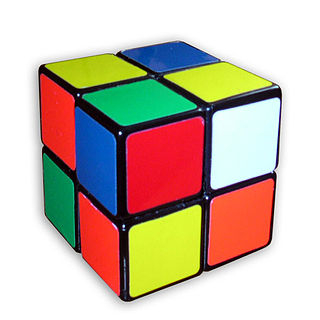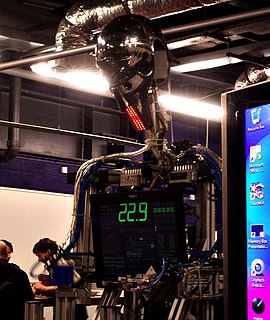 W
WThe Rubik's Cube is a 3-D combination puzzle invented in 1974 by Hungarian sculptor and professor of architecture Ernő Rubik. Originally called the Magic Cube, the puzzle was licensed by Rubik to be sold by Ideal Toy Corp. in 1980 via businessman Tibor Laczi and Seven Towns founder Tom Kremer. Rubik's Cube won the 1980 German Game of the Year special award for Best Puzzle. As of January 2009, 350 million cubes had been sold worldwide, making it the world's bestselling puzzle game and bestselling toy.
 W
WThe 1982 World Rubik's Cube Championship was a competition for speedsolving the 3×3×3 Rubik's Cube.
 W
WCubers is a documentary film directed by Richard LeBlanc and produced by Walter Forsyth. The documentary's production began in Toronto, Ontario, Canada, but visits Paris, Budapest, Orlando, Tel Aviv, Toulouse and more. It was released in North America on CBC The Lens, followed by Biography, Access, and three other major stations.
 W
WCubeStormer 3 is a robot built primarily with Lego Mindstorms and the Samsung Galaxy S4. On 15 March 2014, at the Big Bang fair in Birmingham, England, the CubeStormer 3 broke the previous record, held by its predecessor, the CubeStormer II, for the fastest time to solve a Rubik's Cube. The previous Guinness World Records time was 5.270 seconds. The official time taken to solve the Rubik's Cube by the CubeStormer 3 was 3.253 seconds. This robot was created by inventors David Gilday and Mike Dobson. It took the two of them 18 months to perfect the technology of this robot. The robot was able to conquer the cube by use of four robotic hands. The robot is made out of LEGO and ARM architecture.
 W
WThe Gear Cube is a 3-D combination puzzle designed and created by Dutch puzzle maker Oskar van Deventer based on an idea by Bram Cohen. It was initially produced by Shapeways in 2009 and known as "Caution Cube" due to the likeliness of getting fingers stuck between the gears while speedcubing. Later, in 2010, it was mass-produced by Meffert's as the "Gear Cube".
 W
WInfinity cube is a kind of mechanical puzzle toy with mathematical principles, the shape is similar to a Rubik's cube. It can be opened and put together from different directions, thus creating a visually interesting effect.
 W
WThomas Kremer was a game inventor and marketer who acquired the rights to market the Rubik's Cube.
 W
WThe Megaminx or Mégaminx is a dodecahedron-shaped puzzle similar to the Rubik's Cube. It has a total of 50 movable pieces to rearrange, compared to the 20 movable pieces of the Rubik's Cube.
 W
WThe Mirror Blocks, also known as the Mirror Cube and Bump Cube, is a type of twisty puzzle and shape modification of the standard 3x3x3 Rubik's Cube and was invented in 2006. The puzzle's internal mechanism is nearly identical to that of the Rubik's Cube, although it differs from normal 3x3 cubes in that all pieces are the same color and are identified by shape since each one is also a distinct rectangular prism.
 W
WOptimal solutions for Rubik's Cube refer to solutions that are the shortest. There are two common ways to measure the length of a solution. The first is to count the number of quarter turns. The second is to count the number of outer-layer twists, called "face turns". A move to turn an outer layer two quarter (90°) turns in the same direction would be counted as two moves in the quarter turn metric (QTM), but as one turn in the face metric.
 W
WThe Pocket Cube is the 2×2×2 equivalent of a Rubik's Cube. The cube consists of 8 pieces, all corners.
 W
WThe Professor's Cube is a 3-D combination puzzle, a 5×5×5 version of the original Rubik's Cube. It has qualities in common with both the 3×3×3 Rubik's Cube and the 4×4×4 Rubik's Revenge. The ability to know to solve 3x3x3 Rubik's Cube will help, but it is recommended to know both Cubes to be able to solve the Professor's Cube.
 W
WThe Pyraminx is a regular tetrahedron puzzle in the style of Rubik's Cube. It was made and patented by Uwe Mèffert after the original 3 layered Rubik's Cube by Ernő Rubik, and introduced by Tomy Toys of Japan in 1981.
 W
WErnő Rubik is a Hungarian inventor, architect and professor of architecture. He is best known for the invention of mechanical puzzles including the Rubik's Cube (1974), Rubik's Magic, Rubik's Magic: Master Edition, and Rubik's Snake.
 W
WRubik, the Amazing Cube was a 1983 half-hour Saturday morning animated series based on the puzzle created by Ernő Rubik, produced by Ruby-Spears Enterprises and broadcast as part of The Pac-Man/Rubik, the Amazing Cube Hour block on ABC from September 10 to December 10, 1983 and continued reruns until September 1, 1984. The Rubik half hour was broadcast in reruns as a standalone series on ABC from May 4 to August 31, 1985.
 W
WThe Rubik's Cube group is a group that represents the structure of the Rubik's Cube mechanical puzzle. Each element of the set corresponds to a cube move, which is the effect of any sequence of rotations of the cube's faces. With this representation, not only can any cube move be represented, but also any position of the cube as well, by detailing the cube moves required to rotate the solved cube into that position. Indeed with the solved position as a starting point, there is a one-to-one correspondence between each of the legal positions of the Rubik's Cube and the elements of . The group operation is the composition of cube moves, corresponding to the result of performing one cube move after another.
 W
WThe Rubik's Cube, a 1974 invention of Ernő Rubik of Hungary, fascinated people around the globe and became one of the most popular games in America in the early 1980s, having been initially released as the Magic Cube in Hungary in late 1977, and then re-manufactured and released in the western world as Rubik's Cube in 1980. As of January 2009, 350 million cubes have been sold worldwide making it the world's top-selling puzzle game. It earned a place as a permanent exhibit in New York’s Museum of Modern Art and entered the Oxford English Dictionary in 1982. The Cube retains a dedicated following, with almost 40,000 entries on YouTube featuring tutorials and video clips of quick solutions.
 W
WRubik's Domino is a hand-held puzzle similar to a Rubik's Cube. However, it has one layer removed, making it a 2×3×3 cuboid. The 3×3 faces can be turned 90-degrees as normal, but the 2×3 faces can only be turned 180 degrees. Other cuboids of 2×2×n will solve like multiple dominoes at once. When only using pairs of turns, the puzzle may be solved similarly to a 3x3. The original version had white and black plastic layers. Each 3×3 face displayed a number of dots from 1–9. More recent versions use the traditional six-colour scheme, as seen on most other twisty puzzles. It has 406,425,600 potential positions and any position can be made into a solved position in 19 moves. It was registered as US Patent number 4378116 on 29 March 1983 by Ernő Rubik.
 W
WRubik's Games is a, five games in one, PC game created for Windows 95/98 developed in part by Ernő Rubik with Androsoft and was published by Hasbro Interactive. It was part of Hasbro's classical games collection of PC related games, translating their most famous board games into best possible quality video games. A history of the Rubik's Cube and its inventor, written out in a webpage type file, with pictures is available from the Menu.
 W
WThe Rubik's Revenge is a 4×4×4 version of Rubik's Cube. It was released in 1981. Invented by Péter Sebestény, the Rubik's Revenge was nearly called the Sebestény Cube until a somewhat last-minute decision changed the puzzle's name to attract fans of the original Rubik's Cube. Unlike the original puzzle, it has no fixed facets: the centre facets are free to move to different positions.
 W
WThe Rubik's Revolution is a handheld electronic game invented, designed, developed and patented by Rehco, LLC, a Chicago toy and game inventing firm. The Rubik's Revolution was formerly distributed by Techno Source and received the 2008 TOTY Game of the Year Award. Designed to resemble the classic Rubik's Cube puzzle, the device is a single rigid cube; it is about as large as a Professor's Cube, with each face subdivided into 9 square sub-faces. The center square of each face features a recessed LED-lit button colored to correspond with the stickers on the remaining squares. Gameplay involves pressing the buttons when they light up, or when directed to by the game's recorded voice.
 W
WRuBot II is a Rubik's Cube solving robot developed by Irish roboticist and inventor Pete Redmond. RuBot II was formerly the world's fastest Rubik's Cube-solving robot, and appeared as such in the 2010 Guinness Book of World Records, although its best time has since been well surpassed by a robot called Ruby built at Swinburne University of Technology in Melbourne, Australia in 2011.
 W
WThe Simple Solution to Rubik's Cube by James G. Nourse is a book that was published in 1981. The book explains how to solve the Rubik's Cube. The book became the best-selling book of 1981, selling 6,680,000 copies that year. It was the fastest-selling title in the 36-year history of Bantam Books.
 W
WDavid Breyer Singmaster is a retired professor of mathematics at London South Bank University, England, UK. A self-described metagrobologist, he has a huge personal collection of mechanical puzzles and books of brain teasers. He is most famous for being an early adopter and enthusiastic promoter of the Rubik's Cube. His Notes on Rubik's "Magic Cube" which he began compiling in 1979 provided the first mathematical analysis of the Cube as well as providing one of the first published solutions. The book contained his cube notation which allowed the recording of Rubik's Cube moves, and which quickly became the standard.
 W
WThe Speed Cubers is a 2020 documentary on the lives of speedcubing champions Max Park and Feliks Zemdegs directed by Sue Kim.
 W
WThe superflip or 12-flip is a Rubik's Cube configuration in which all 20 of the movable subcubes are in the correct permutation, and the eight corners are correctly oriented, but all twelve of the edges are oriented incorrectly ("flipped"). It has been shown that the shortest path between a solved cube and the Superflip position requires 20 moves under the usual half-turn metric, and that no position requires more.
 W
WMorwen Bernard Thistlethwaite is a knot theorist and professor of mathematics for the University of Tennessee in Knoxville. He has made important contributions to both knot theory and Rubik's Cube group theory.
 W
WThe V-Cube 6 is a 6×6×6 version of the original Rubik's Cube. The first mass-produced 6×6×6 was invented by Panagiotis Verdes and is produced by the Greek company Verdes Innovations SA. Other such puzzles have since been introduced by a number of Chinese companies, some of which have mechanisms which improve on the original. Unlike the original puzzle, it has no fixed facets: the center facets are free to move to different positions.
 W
WThe V-Cube 7 is a combination puzzle in the form of a 7×7×7 cube. The first mass-produced 7×7×7 was invented by Panagiotis Verdes and is produced by the Greek company Verdes Innovations SA. Other such puzzles have since been introduced by a number of Chinese companies, some of which have mechanisms which improve on the original. Like the 5×5×5, the V-Cube 7 has both fixed and movable center facets.
 W
WThe V-Cube 8 is an 8×8×8 version of the Rubik's Cube. Unlike the original puzzle, it has no fixed facets: the center facets are free to move to different positions. The design was covered by Panagiotis Verdes' patent from 2007 but Verdes Innovations SA did not produce it for sale until 2014. Other 8×8×8 cubes are produced by the Chinese companies QiYi, Cyclone Boys, ShengShou, MoYu, and YuXin.
 W
WThe Void Cube is a 3-D mechanical puzzle similar to a Rubik's Cube, with the notable difference being that the center pieces are missing, which causes the puzzle to resemble a level 1 Menger sponge. The core used on the Rubik's Cube is also absent, creating holes straight through the cube on all three axes. Due to the restricted volume of the puzzle it employs an entirely different structural mechanism from a regular Rubik's Cube, though the possible moves are the same. The Void Cube was invented by Katsuhiko Okamoto. Gentosha Education, in Japan, holds the license to manufacture Void Cubes.
 W
WThe World Cube Association (WCA) is the worldwide non-profit organization that regulates and holds competitions for mechanical puzzles that are operated by twisting groups of pieces, commonly known as twisty puzzles. The most famous of those puzzles is the Rubik's Cube. The WCA was founded by Ron van Bruchem of the Netherlands and Tyson Mao of the United States in 2004. The goal of the World Cube Association is to have "more competitions in more countries with more people and more fun, under fair conditions." In 2017, they started work to become a non-profit organization and on November 20, 2017 the state of California accepted the initial registration of the World Cube Association.